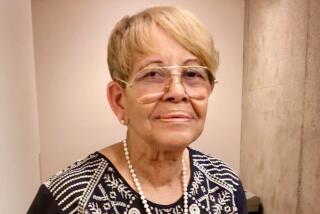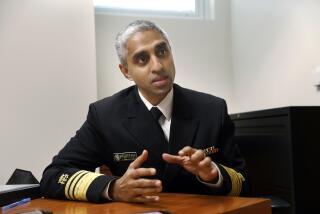Surgeon Kept Heart Transplant Field Alive
Dr. Norman Shumway, the Stanford surgeon recognized as the father of heart transplant surgery, died Friday morning at his home in Palo Alto of complications from cancer, the Stanford University School of Medicine announced.
He died one day after his 83rd birthday.
Although Dr. Christiaan Barnard of South Africa performed the world’s first heart transplant in Cape Town in December 1967, beating out Shumway by a month, he did it using techniques developed by Shumway over the preceding decade.
And while Barnard virtually abandoned the field after a few years because of the high mortality rate associated with the then-radical surgery, Shumway returned to his laboratory to develop the anti-rejection techniques and patient care that eventually made the procedure a valuable choice of last resort for those with badly diseased hearts.
Today, nearly 60,000 heart transplants have been performed at 300 centers around the world, all of them using the techniques pioneered by the Stanford surgeon.
In the United States alone, more than 2,000 heart transplants are performed each year, with a one-year survival rate of about 85%. The number would be much higher, experts agree, if more donor hearts were available.
Shumway “was an absolute giant in the field of cardiothoracic surgery,” said Dr. Nancy Asher, chair of the department of surgery at the UC San Francisco Medical Center. “He approached it not just as a surgeon, but also as a scientist.”
When everybody else gave up on the technique, Asher said, he spent a decade asking, “How can I make this right?”
Shumway “almost single-handedly perfected the procedure in that lonely decade” when virtually everybody else had given up on it, said Dr. Robert Brewer, director of cardiac transplantation at Henry Ford Health System in Detroit.
“It’s hard to overestimate his importance” to the field, Brewer added.
Shumway was entering virtually uncharted territory with the heart when he arrived at Stanford in 1958. Only a couple of decades earlier, the heart had been viewed as the repository of the human spirit and was a location where surgeons feared to tread.
That attitude began to change when a young U.S. Army surgeon, Dr. Dwight Harken, struggled to find a way to remove shrapnel from the heart.
He ultimately developed a technique to cut into the wall of a beating heart, insert a finger, remove the fragment, and then close it up again, proving that the human heart could be operated on.
Over the next decade, surgeons began using primitive heart-lung machines to provide blood and oxygen to the body while they stilled the heart to make repairs, and introduced the technique of whole-body hypothermia — cooling the body to near room temperature — to reduce metabolism and oxygen demand during surgery.
Even so, operations had to be performed quickly, meaning that only small congenital defects could be corrected. If the procedures ran on too long, hearts had a disconcerting propensity not to begin beating again.
In his first years at Stanford, Shumway built on previous work to develop a simple technique, called topical myocardial hypothermia, to cool only the heart. This, Shumway wrote later, “provided plenty of time for any procedure we cared to do. From then on, we were only limited by our imagination, rather than by the fear the heart would not beat again.”
Over the next few years, working on dogs, Shumway and his chief resident, Dr. Richard Lower, developed a technique for removing the heart completely, then re-implanting it.
After some studies, they concluded that this could actually be performed more readily — surgically, at least — by inserting the heart from a second dog. The trick, they found, was to leave extra lengths of artery in both the donor heart and the patient to allow a good splice to be made.
On Nov. 20, 1967, Shumway announced that the time was right to proceed with the procedure in humans if a good patient and a good donor could be found.
But in early December, while Shumway was searching for the right patients, Barnard — who had picked up the surgical technique from Lower — transplanted the heart of a 23-year-old woman killed in an automobile accident into the chest of a middle-aged man. The patient lived 18 days before dying of pneumonia exacerbated by the powerful anti-rejection drugs Barnard used.
Shumway might have had a patient about the same time, but the potential donor’s family balked. It was not until Jan. 6 that he performed his first transplant, on Mike Kasperak, a 56-year-old man whose heart had been severely damaged by a viral infection. Kasperak died 14 days later.
Barnard’s next patient, however, survived 18 months, and the success set off a wave of heart transplants around the world.
“It’s a relatively easy operation,” Shumway said later, “and that’s probably one of the things that was wrong from the beginning. It was easy enough to be done in India or Chile or almost anywhere with successful immediate results, but it’s what happens later with regard to the containment of rejection that makes the real difference.”
By 1971, 146 of the first 170 heart transplant patients were dead, and what had looked like a surgical miracle had turned into a disaster. Cardiac surgeons admitted defeat and called for a complete moratorium on heart transplants.
But Shumway refused to honor the moratorium, spending the next decade building a team to conquer the scientific and procedural problems associated with the transplant. He found ways to enlarge the pool of both donors and recipients, and devised techniques to preserve hearts for transport before the transplant.
His team found a way to spot rejection early, threading a catheter into the heart and removing a small piece of muscle for examination. Only if signs of rejection were present did it become necessary to administer the powerful immunosuppressants then used to stifle the body’s defenses.
In late 1980, his team was the first to use the newly developed anti-rejection drug cyclosporine, isolated from a fungus in the soil of Norway’s Hardanger Fiord. That drug, which fought rejection without destroying the body’s defenses against infection, was the final component needed to make heart transplants a common procedure.
In 1981, Shumway and Dr. Bruce Reitz performed the world’s first combined heart and lung transplant, in 45-year-old advertising executive Mary Gohlke, who lived five more years and wrote a book about her experience. By the end of the decade, they were transplanting hearts into infants as well.
As a result of his achievements, “Dr. Shumway is the recipient of virtually every award that surgery has to offer,” said Dr. Thomas Krummel of Stanford.
Norman Edward Shumway was born in Kalamazoo, Mich., on Feb. 9, 1923. He enrolled in the University of Minnesota intending to become a lawyer, but was drafted by the Army in 1943 after only two years of schooling. After basic training, he was sent to John Tarleton Agricultural Junior College — now Tarleton State University — in Stephenville, Texas, for engineering training.
At the end of six months, he was given an Army medical aptitude test. The final question was, “If you were to pass this test, would you prefer a career in medicine or dentistry?” He checked the box marked “medicine,” and his life was changed forever.
He was enrolled in an Army specialized training program that consisted of a nine-month pre-medicine preparatory course at Baylor University in Waco, Texas, and medical school at Vanderbilt University in Nashville, where he graduated in 1949.
After Vanderbilt, he completed a year of residency and a year of training in surgery before being drafted into the Air Force in 1951, serving as a flight surgeon in Lake Charles, La. Upon his discharge, he returned to Minnesota, where he finished his training and received a doctoral degree.
Moving west, he established a private surgical practice at Cottage Hospital in Santa Barbara, but after only six weeks, he was invited to join the Stanford surgical faculty. By 1964, he became the chief of cardiothoracic surgery there on the understanding that the position was temporary until a “big name” came along. He remained chief until he retired in 1993.
Shumway was known for allowing his students to take the lead in surgeries, an approach substantially different from that of his contemporaries and competitors.
“I might not be the best surgeon in the world,” he frequently said, “but I certainly must be the best first assistant.”
As a consequence of this hands-on approach, he trained many of the most prominent first- and second-generation surgeons in heart transplantation.
Shumway was a modest and unassuming man who never touted his own achievements and was shocked when 150 reporters showed up on campus after the pioneering first transplant.
For years, he drove around campus in a battered brown Datsun 240Z with a hole in the floorboard “that you could see the street through,” Asher said.
“I never saw him in a bad humor; I never saw him angry,” said colleague and golfing buddy Dr. James Mark. “He was a man without ego. Whether it was his car, his clothes, his shoes or his golf clubs, he never did it for show.”
Around the hospital, he was always dressed in surgical greens. “I never knew he had any clothes,” Mark said.
“One morning he came in dressed in baggy pants, a ratty sport coat, a yellow shirt and a tie with a horse on it,” Mark added. “I asked him why he was dressed up, and he said he was going to court as an expert witness. Then he said something unprintable.”
Mark suggested he go home and change to look more like the lawyers and others in court. He said Shumway later told him that he thought about changing, but ultimately decided not to.
“When I got there,” Shumway told Mark, “the lawyers all had on fancy suits, but the jury looked like me, and they were paying attention to me, not to the lawyers.”
Shumway is survived by his former wife, Mary Lou of Palo Alto; four children, Sarah, a professor of cardiothoracic surgery at the University of Minnesota and the coauthor with her father of “Thoracic Transplantation”; Lisa, a business development manager for a computer company; Amy, a retail manager; and Michael, a CPA and controller of a law firm; and two grandchildren, Sienna and Sander.
The family has asked that any memorial donations be made to the Stanford University Heart Transplant Patient Care fund.
Services are pending.
More to Read
Sign up for Essential California
The most important California stories and recommendations in your inbox every morning.
You may occasionally receive promotional content from the Los Angeles Times.










